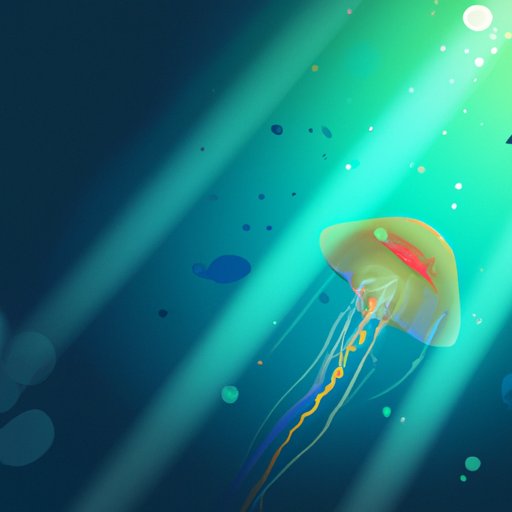Introduction
Have you ever wondered how sound and light travel differently in water compared to air? It’s a fascinating topic, and one that’s often misunderstood. In this article, we’ll explore the science behind sound and light in water, the role of sound in marine research, the impact of underwater noise pollution, and the future of underwater acoustics. Let’s dive in!
The Speed of Sound in Water: A Comparison to the Speed of Light
Sound waves are vibrations that travel through a medium, such as air or water. The speed of sound in water is much faster than in air, due to the higher density of water molecules. On the other hand, the speed of light is slower in water than in air, as water molecules absorb and scatter light waves.
To put this into perspective, the speed of sound in air at room temperature is about 343 meters per second, while in water it is about 1,482 meters per second. The speed of light in air is approximately 299,792,458 meters per second, but in water, it slows down to about 225,000 kilometers per second.
The reason why sound travels faster in water is due to the tightly packed molecules in water, which facilitates the transfer of energy between particles. Light, however, interacts differently with the water molecules due to its electromagnetic nature, resulting in a slower speed.
Exploring the Depths: How Deep-Sea Creatures Use Sound to Navigate
Underwater creatures have evolved to use sound as a means of communication and navigation. Sound waves travel much further and faster in water compared to air, making it an effective tool for marine mammals, such as whales and dolphins, to communicate with each other over long distances.
For example, some species of whales use low-frequency sounds to communicate with other members of their pod, while dolphins use high-pitched clicks to locate prey and navigate their surroundings. Additionally, some fish species use sound for courtship and spawning purposes.
The importance of sound in the survival of underwater organisms cannot be overstated, as it allows them to find food, mates, and avoid predators.
The Role of Sound in Marine Research: How Scientists ‘Listen’ to the Depths
Scientists have also harnessed the power of sound to better understand underwater environments. Oceanographers and acoustic specialists use a variety of technologies and techniques to study the oceans, from hydrophones that are dropped to the ocean floor to autonomous underwater vehicles (AUVs) equipped with sonar systems.
Examples of research projects that rely on sound include the study of underwater earthquakes and the effects of climate change on marine ecosystems. By analyzing the sound waves generated by these events, scientists can learn more about the structure and behavior of the ocean floor, and predict future conditions that may impact marine life.
Overall, sound allows scientists to ‘listen’ to the oceans and gain insights into a vast, mysterious environment that is often difficult to explore otherwise.
Underwater Noise Pollution: How Human Activities are Affecting Marine Life
Unfortunately, human activities such as shipping, drilling, and sonar testing have introduced high levels of anthropogenic noise into the oceans, leading to negative impacts on marine life. Noise pollution can interfere with the communication and navigation abilities of marine organisms, which can ultimately lead to disrupted mating patterns, decreased foraging success, and increased stress levels.
Anthropogenic noise has also been linked to more serious consequences, such as mass strandings of whales and dolphins. In some cases, marine mammals have beached themselves after becoming disoriented or unable to communicate with their pod in the presence of high levels of underwater noise.
In addition, underwater noise pollution can also have long-term effects on marine ecosystems, as it can alter the behavior and distribution of important species, and ultimately impact the diversity of life in the ocean.
The Future of Underwater Acoustics: Innovations in Underwater Communication
The field of underwater acoustics is rapidly evolving, with new technologies being developed to improve communication and exploration in the oceans. One of the most exciting innovations is the development of underwater wireless communication systems, which can enable real-time communication between AUVs and submarines over long distances.
Other advancements include the use of acoustic holography to create high-resolution 3D maps of the seafloor, and the development of new autonomous underwater vehicles that can navigate and explore the ocean autonomously.
Overall, these new technologies have the potential to revolutionize our understanding of the oceans and improve our ability to study and conserve marine life.
Famous Shipwrecks and Their Sounds: Exploring the Acoustic Signatures of Sunken History
Finally, one area where underwater acoustics has found a unique application is in the study of shipwrecks and other underwater artifacts. Sound waves can be used to ‘image’ the seafloor and detect the presence of sunken structures, while acoustic signatures can provide important clues about the age and history of a wreck.
For example, the Titanic’s wreck has been extensively studied using acoustic methods, with researchers analyzing the sounds it emits to learn more about its structural integrity and the damage it sustained during its sinking.
By listening to the sounds of the past, underwater acoustics allows us to piece together the stories of legendary vessels and uncover new insights into our maritime history.
Conclusion
Sound is a powerful tool that is essential for life in underwater environments. From communication to navigation to research, sound plays a critical role in our understanding of the oceans and the creatures that inhabit them.
As we continue to explore and develop new technologies, it’s important that we also prioritize the conservation and protection of marine life from the negative effects of underwater noise pollution. With the right balance of innovation and responsibility, we can unlock the secrets of the deep and ensure a brighter future for our oceans.
(Note: Is this article not meeting your expectations? Do you have knowledge or insights to share? Unlock new opportunities and expand your reach by joining our authors team. Click Registration to join us and share your expertise with our readers.)
